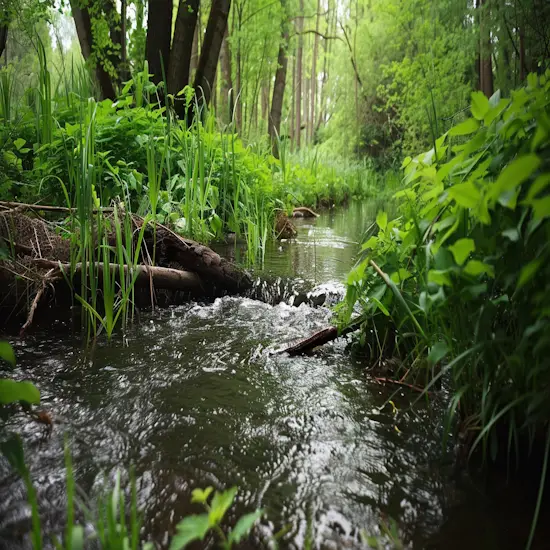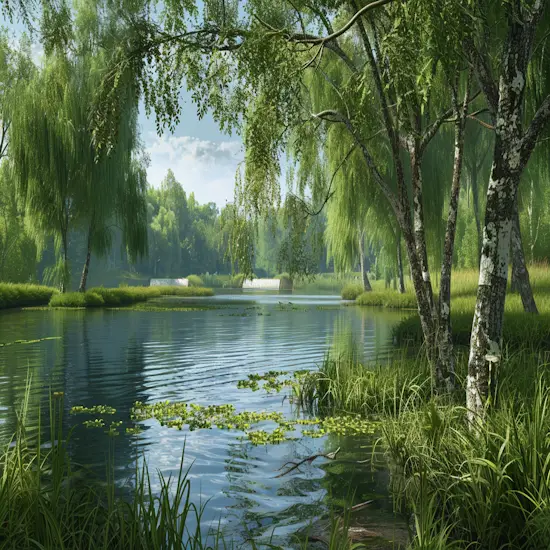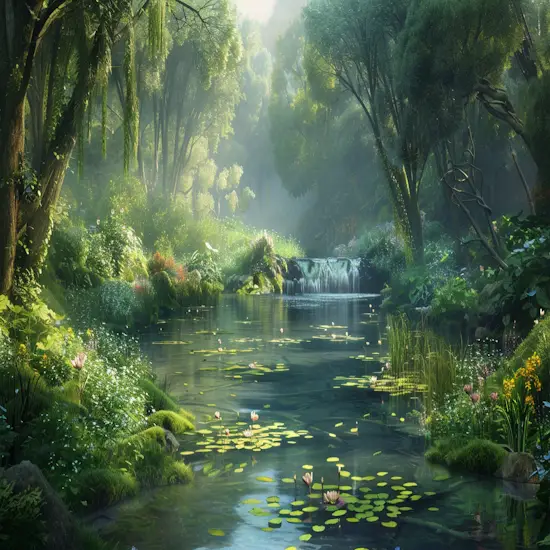Disclosure: We may earn commissions if you purchase products after clicking on a link from our site.
Would you like to learn how to attract beavers to your area? Beavers are creative and industrious but can be very destructive. They are more active during the night. In this article, we discuss how to attract beavers, how to create a habitat to attract beavers to your area, and other strategies. Discover the secrets behind luring beavers and fostering a thriving ecosystem in your backyard.

Table of Contents
Key Takeaways
- Plant willow stakes and red osier dogwood near water bodies.
- Create diverse riparian vegetation with willows, birch, and alder.
- Use Beaver Dam Analogs (BDAs) and log jams to enhance habitat.
- Ensure a variety of native plants for food and shelter.
- Allow time for beavers to establish and thrive in the area.

Planting to Attract Beavers
If you want to attract beavers, focusing on ideal plants is key. Willows, red osier dogwood, and other native species can be effective choices. Riparian vegetation benefits not only the beavers but also the ecosystem as a whole.
Ideal Beaver Plants
To attract beavers effectively, prioritize planting willow stakes and red osier dogwood as they’re favored by these industrious creatures for food and habitat enhancement. Willows regenerate quickly and are a favorite food source for beavers. Red osier dogwood is another plant that can attract beavers to your area.
Beavers prefer locations with an abundance of food, so planting these ideal species increases the likelihood of them staying. By providing these plants, you create a welcoming environment for beavers to thrive.
Effective Planting Techniques
For effective planting techniques to attract beavers, prioritize species like willow stakes and red osier dogwood, favored by these industrious creatures for food and habitat enhancement.
- Plant Willow Stakes: Beavers are drawn to willow stakes for food and dam building.
- Consider Red Osier Dogwood: This plant provides additional food sources and habitat diversity.
- Ensure Abundant Native Vegetation: Beavers prefer areas with a variety of native plants for sustenance and shelter.
Riparian Vegetation Benefits
After focusing on effective planting techniques, you can now explore the benefits of riparian vegetation in attracting beavers.
Riparian vegetation plays an important role in enticing beavers to inhabit an area. By planting willows, red osier dogwood, and other preferred species, you create a favorable environment for beavers. Willows, in particular, regenerate quickly and are a favorite food source for these industrious creatures.
Having abundant riparian vegetation increases the likelihood of beavers staying in the area, contributing to ecosystem restoration and biodiversity. Remember, beavers rely on vegetation for food and shelter, so planting the right species can greatly enhance their habitat and encourage their presence.

Benefits of Planting for Beavers
Planting for beavers brings numerous benefits. Rapid willow regeneration guarantees a quick and reliable food source for these creatures. Diverse food options attract beavers and play a vital role in restoring the ecosystem.
Rapid Willow Regeneration
To promote rapid willow regeneration, prioritize planting native species like willow, which are essential for attracting and sustaining beavers in an area.
- Choose willow stakes for quick growth
- Guarantee adequate water supply for best regeneration
- Protect young willow shoots from browsing animals
Diverse Food Sources
For attracting beavers through diverse food sources, consider planting a variety of native plants like willow, beech, maple, birch, alder, and oak to provide a range of options for their dietary needs.
| Native Plants | Benefits for Beavers |
|---|---|
| Willow | Favorite food source |
| Beech | Nutrient-rich |
| Maple | Energy-dense |
These plants offer essential nutrients and energy for beavers, encouraging them to stay in the area. By providing a diverse array of food sources, you can attract and sustain beaver populations effectively. Remember, a well-fed beaver is more likely to establish its presence and contribute positively to the ecosystem.
Ecosystem Restoration Role
For a successful and sustainable beaver habitat, consider diversifying the native plants to provide a range of essential nutrients for their dietary needs.
- Willows regenerate quickly, which are beavers’ favorite food.
- Red osier dogwood can also be planted to attract beavers.
- Beavers prefer areas with abundant food sources.
Planting a variety of these plants not only attracts beavers but also enhances the ecosystem’s health by providing essential food sources for these industrious creatures. By promoting the growth of these native plants, you contribute to the restoration of riparian areas and support the crucial role that beavers play in maintaining a balanced and thriving ecosystem.

Challenges in Attracting Beavers
Attracting beavers can pose challenges due to their specific plant preferences, scarcity of food sources, and varying effectiveness of attraction methods. You may encounter difficulties in keeping beavers in an area if the plants they prefer aren’t abundant.
Ensuring a consistent food supply and using essential attraction techniques are crucial to successfully drawing beavers to your desired location.
Plant Preference Variability
To successfully attract beavers, understanding their specific plant preferences is essential. Beavers can be selective about the vegetation they consume, which can pose challenges when trying to attract them to a particular area.
Here are some key points to take into account regarding plant preference variability:
- Beavers have varying preferences for different plant species.
- Certain plants like spirea, elderberry, and most conifers are generally avoided by beavers.
- Willows are a favorite food source for beavers due to their regenerative properties and are an effective plant to attract them with.
Food Source Scarcity
Securing the impact of food source scarcity is key when trying to attract beavers to a specific area. Beavers rely heavily on a variety of plants for sustenance, and a shortage of their preferred food can drive them away. If the area lacks the vegetation that beavers typically feed on, such as willow, beech, maple, birch, alder, and oak, they’re less likely to stay.
It’s crucial to guarantee a diverse range of native plants that beavers enjoy are present to increase the chances of attracting and maintaining a beaver population. By addressing food source scarcity through strategic planting and habitat management, you can create a more inviting environment for beavers to thrive.
Attraction Method Effectiveness
For effective attraction of beavers, consider the method’s success rates in drawing them to specific areas.
- Planting willow stakes has shown high effectiveness in attracting beavers.
- Using beaver castor as bait can be a compelling method to lure beavers.
- Incorporating the scent of other beavers or their favorite foods in the attraction process can increase success rates.

Importance of Riparian Vegetation
To attract beavers successfully, it’s important to understand the benefits of riparian vegetation. The plants you choose matter greatly, as beavers rely on specific vegetation for food and shelter.
Riparian Vegetation Benefits
Planting riparian vegetation plays a vital role in supporting the survival and habitat of beavers. This vegetation along the water’s edge provides essential benefits for these industrious creatures:
- Food Source: Riparian vegetation offers beavers a natural buffet of leaves, twigs, and bark to munch on.
- Shelter: The dense vegetation acts as a protective cover for beavers, providing security from predators and harsh weather conditions.
- Erosion Control: The roots of riparian plants help stabilize the soil along riverbanks, preventing erosion and maintaining the integrity of the beavers’ habitat.
Plant Choices Matter
When considering attracting beavers to your area, the selection of suitable plants becomes a vital factor in their habitat preference and sustainability. Beavers have specific plant preferences, with willows being a favorite due to their quick regeneration. Red osier dogwood is another plant that can attract beavers to your area. Planting these preferred species increases the probability of beavers staying, as they rely on abundant food sources for survival.
Beavers play an important role in ecosystem restoration, making it essential to provide the right vegetation for their habitat. By planting willow stakes and other preferred species, you can create a beaver-friendly environment that supports biodiversity and the overall health of riparian ecosystems.
Restoring Riparian Zones
Restoring riparian zones requires a focus on the essential role that riparian vegetation plays in supporting beavers’ survival and ecosystem health.
- Riparian vegetation provides food and shelter for beavers.
- Healthy riparian areas contribute to ecosystem balance.
- Planting native species like willow and alder can attract and sustain beaver populations.

Creating Beaver-Friendly Habitats
To create habitats that attract beavers, start by planting willow stakes, enhancing biodiversity along riparian areas, and building wetland habitats.
By incorporating these practices, you can encourage beavers to establish their presence in your surroundings, contributing to ecosystem health and restoration.
Providing suitable environments for beavers benefits not only these creatures but also the broader ecosystem they help sustain.
Planting Willow Stakes
Planting willow stakes effectively attracts beavers to create a habitat-friendly environment for these creatures. Willow stakes are a preferred food source for beavers and serve as essential building materials for their dams and lodges. By planting willow stakes, you can increase the likelihood of beavers choosing to stay in the area.
Here are some key points to ponder:
- Willows regenerate quickly, providing a sustainable food source for beavers.
- Red osier dogwood can also be planted to attract beavers due to its palatability.
- Beavers prefer areas with abundant food, so planting a variety of their favorite plants can help in maintaining their presence.
Enhancing Riparian Biodiversity
Enhancing riparian biodiversity involves creating habitats that are friendly to beavers. To attract these ecosystem engineers, plant native species such as willow, beech, maple, birch, alder, and oak along the water’s edge. Guarantee various aquatic vegetation grows on the water’s surface to provide a diverse food source.
Consider using BDAs (beaver dam analogs) to enhance their habitat and create log jams to naturally slow down water flow. It’s crucial to be patient as beavers may take time to establish themselves in the area.
Building Wetland Habitats
Build wetland habitats that are conducive to attracting beavers by incorporating native vegetation and creating suitable conditions for their presence.
To create beaver-friendly habitats:
- Plant willow stakes to attract beavers
- Guarantee a variety of native species like beech, maple, and alder grow
- Construct log jams to naturally slow down water flow
How to attract beavers to your area can be challenging but it can be done. To attract beavers, you will have to plant and create the habitat that they thrive in to attract them to your area. This requires patience and effort.
Beavers help sustain the environment and the ecosystem. In this article, we discussed how to attract beavers to your area and share information to make it possible. You can also learn how to hunt beavers and how to hunt beavers at night.
